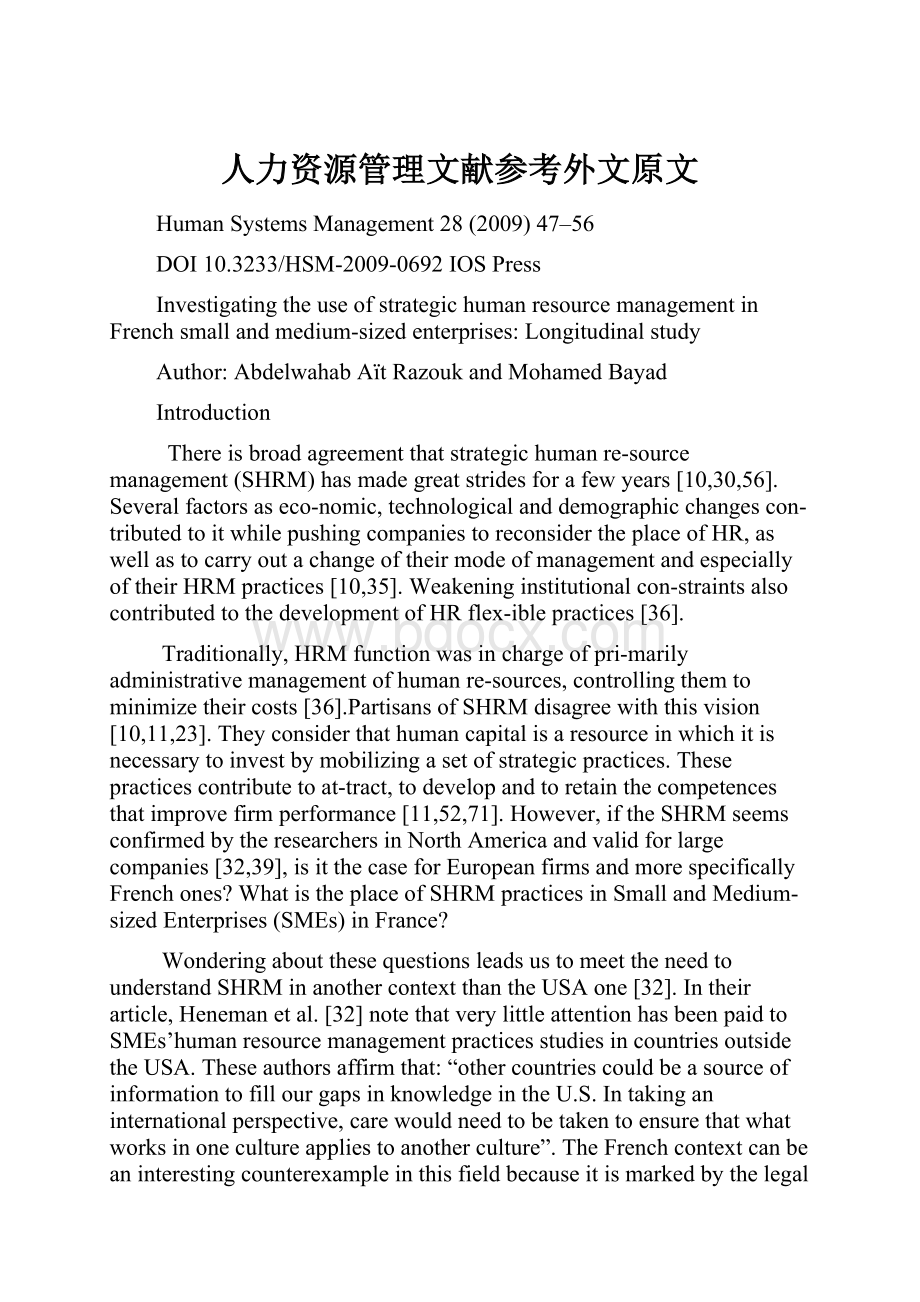人力资源管理文献参考外文原文.docx
《人力资源管理文献参考外文原文.docx》由会员分享,可在线阅读,更多相关《人力资源管理文献参考外文原文.docx(12页珍藏版)》请在冰豆网上搜索。

人力资源管理文献参考外文原文
HumanSystemsManagement28(2009)47–56
DOI10.3233/HSM-2009-0692IOSPress
InvestigatingtheuseofstrategichumanresourcemanagementinFrenchsmallandmedium-sizedenterprises:
Longitudinalstudy
Author:
AbdelwahabAïtRazoukandMohamedBayad
Introduction
Thereisbroadagreementthatstrategichumanre-sourcemanagement(SHRM)hasmadegreatstridesforafewyears[10,30,56].Severalfactorsaseco-nomic,technologicalanddemographicchangescon-tributedtoitwhilepushingcompaniestoreconsidertheplaceofHR,aswellastocarryoutachangeoftheirmodeofmanagementandespeciallyoftheirHRMpractices[10,35].Weakeninginstitutionalcon-straintsalsocontributedtothedevelopmentofHRflex-iblepractices[36].
Traditionally,HRMfunctionwasinchargeofpri-marilyadministrativemanagementofhumanre-sources,controllingthemtominimizetheircosts[36].PartisansofSHRMdisagreewiththisvision[10,11,23].Theyconsiderthathumancapitalisaresourceinwhichitisnecessarytoinvestbymobilizingasetofstrategicpractices.Thesepracticescontributetoat-tract,todevelopandtoretainthecompetencesthatimprovefirmperformance[11,52,71].However,iftheSHRMseemsconfirmedbytheresearchersinNorthAmericaandvalidforlargecompanies[32,39],isitthecaseforEuropeanfirmsandmorespecificallyFrenchones?
WhatistheplaceofSHRMpracticesinSmallandMedium-sizedEnterprises(SMEs)inFrance?
WonderingaboutthesequestionsleadsustomeettheneedtounderstandSHRMinanothercontextthantheUSAone[32].Intheirarticle,Henemanetal.[32]notethatverylittleattentionhasbeenpaidtoSMEs’humanresourcemanagementpracticesstudiesincountriesoutsidetheUSA.Theseauthorsaffirmthat:
“othercountriescouldbeasourceofinformationtofillourgapsinknowledgeintheU.S.Intakinganinternationalperspective,carewouldneedtobetakentoensurethatwhatworksinonecultureappliestoanotherculture”.TheFrenchcontextcanbeaninterestingcounterexampleinthisfieldbecauseitismarkedbythelegalconstraintsandtheinstitutions,inparticularunions,inspiteoftheirweakeningduringthelastdecade[14,15,28].
Bythisstudy,wewilltrytoenrichourknowledgeinSHRMinSMEs.ResearchonSHRMinSMEsremainslittledevelopedingeneral[34]andparticularlyinFrance[1,12,44,58].OurinteresttostudyFrenchSMEscanbealsojustifiedbytheircapacityforadaptingandcreatingwealth[24].Inaddition,althoughforalongtimeHRMpracticesinSMEsweregivenaminorplace,recentstudiessupportedtheSMEs’tendencytoinvestmoreandmoreinHRandinvitedtointensifyresearchonHRMpracticesinSMEs[4,68].
Thispaperisorganizedasfollows.InSection2,wewilldeveloptheoriginsofSHRM,itsdefinitionanditspositionintheliteratureofSMEs.Section3will
relatetoresearchmethodology.Finally,theresultswillbeexposedinSection4anddiscussedinSection5withtracksforfutureresearch.
RelationshipbetweenHRMandstrategy:
Whatandwhy?
TheoristsandpractitionersalwayswantedtomakeHRMavectorofthestrategy,carryingitfromopera-tionalleveltostrategiclevel.AccordingtoUlrichandBrockbank[65],thiswayHRMgainsincredibility.AuthorssuchasDruckerestimated,fromthe1970s,thatthisintegrationofhumanresourcestothefieldof
strategyhasbecomenecessarybecauseitisnotenoughanymore“tomakethingswell”,byimprovingeffi-ciency(orproductivity)butitisalsonecessary“to
makethegoodthings”,i.e.toincreaseeffectiveness.TherelationshipbetweenHRMandstrategyisbuiltalsobythemeansofachangeinthestrategicparadigm
aswellasintheroleofhumancapital.
Strategicparadigmchange
Traditionally,strategywasdominatedbyexternalapproachofstrategy,definedasthesetofdecisioncri-teriachosenbythecompanymanagerstodirect,inadeterminingwayandtowardstheduration,firm’sac-tivitiesandconfiguration[40,51,53].Thisapproach,primarilyinspiredbyContingencyTheory[16,18,40,51],isassociatedtodaywithinternalapproachofstrat-egy[6,50].Thenewstrategicvisionsupportsthatbothinternalandexternalapproachesofstrategyareindis-sociableandcomplementary.Inthisway,thedefini-tionofstrategymustintegratefirm’sinternalresourceswhichdetermineitsformulationanditsimplementa-tion[6,50].SHRMemergedthroughthischangeofstrategicvision[11,22].
InHRMliterature,relationshipsbetweenHRMandstrategyareconceivedaccordingtothisnewvisionofstrategy.BairdandMeshoulam[5]havedefined,forexample,therelationshipbetweenHRMandstrat-egyasthecombinationofverticalfitandhorizontalfit,whichexplainshowHRMcouldcontributetotheachievementofstrategicobjectives.Verticalfitisde-fendedbyseveralimportantstrategicmodels.AmongthemodelsmostquotedintheliteratureinSHRM,letusnotethoseelaboratebyPorter[53,54]andbyMilesandSnow[46,47].AccordinglytoPorter,forexample,threestrategicpositioningcanbeconsideredascom-petitiveadvantage.Thesearestrategiesofdifferentia-tion,ofcostsandoffocus.Porterthinksthatacompanywhichpursuesastrategyofcostsminimizationwillof-ferproductsandqualityserviceswhilebettingespe-ciallyontechnologicalinnovation,economiesofscaleandthecontrolofproductioncosts.ToadoptaHRMsystem,itshouldbetakenintoaccount,asLiouvilleandBayad[44]havespecifiedit,jobdesign,traininglinkedwithproductivityincrease,performanceevalua-tion,compensationrelatedtointernalequity,etc.Con-versely,acompanywhichchoosesdifferentiationwillbeledtooffernewproductsandservicesbyintensify-inginnovationinthisfield.Inthisobjective,HRMwillbeconsideredasproactiveandflexible.Itcanrestonbroadautonomy,managementofcompetences,com-pensationrelatedtoindividualobjectives,etc.Lastly,thecompanywhichpursuesastrategyoffocuswilladoptanintermediatemodelwhichmixestheassetsofthetwoprecedingstrategies.Thistypeofcompanywillbeinclinedtofavor,asproposedbyWalton[67],asys-temof“hybrid”HRMwhichdrawsfrombothHRMsystemscarriedbycompanieswhosestrategyisbasedondifferentiationorlowerscosts.
Humanresourcedeterminingstrategy
Authorslike[10,35,56]estimatethatHRMpracticesarenotonlytheresultoffirm'sstrategicorientationssincetheycanalsopartlydeter-minethem.HRMpracticesinparticularareassetsbe-hindthedevelopmentofspecificcompetencieswhich,consequently,contributetothedefinitionoffirmstrat-egy.Thisallusiontofirms’internalcompetencesindi-catestheevolutionofvariousstrategyresearchtrends,thankstothecontributionoftheResourcesBasedView
theory[6,8].Thesereflectionswerefinallyreinforcedbytheworkscarriedoutinto“corecompetencies”[31]andintothe“bestpractices”ofhumanresource,des-ignatedassourcesofcompetitiveadvantage[1,29,49,52].Fortenyears,theevolutionofthestrategyfieldthushasshowedtheprogressiveswitchfromanex-ternalrepresentationofthecompetitiveadvantageto-wardsaninternalanalysisofskills,capacitiesandmoregenerallyofresourcesnoteasilysubstitutableandim-itable[9].
SHRMpractices:
Whatisit?
SHRMismainlydefinedasasetofcoherentpractices,intendedforthereachofthebestlong-termperformance[20,71].ThisapproachofHRstrat-egyemergeslikeaconsensualvisionamongthere-searchersinspiteoftheexistenceofotherpositions.Indeed,theliteratureissharedbetweenauthorswhostudySHRMthroughtheHRdepartment[60],otherswhofocusesonfirm’shumancapital(employees’col-lectiveknowledge,skillsandabilities)[32,43,48,57,72]and,finally,thosewhodefineHRMasindividualpractices[62,70]orbundles[20,29].ConcerningHRdepartment,forexample,wecanquotethecontribu-tionsofUlrich[63,64]andTysonandFell[61].TysonandFelldrewupakindoftypologyofthevariousHRprofessionals,accordingtothedominanttaskstheysetupforthisfunctioninthefirm.TheauthorsidentifythreegreattypesofHRprofessionals:
theexecutant,theadministratorofcontracts,thearchitect.ThisfirsttypologyisdeepenedandenrichedbytheworksofUl-rich[63,64],andUlrichandBrockbank[65]whoiden-tifiedtheprincipalrolesthoseHRprofessionalsmustplaytobeabletobegraduallycommittedtothestrate-giclevel:
lawyeroftheemployees,developerofhumancapital,functionalexpert,strategicpartner,HRleader.However,thevisionofSHRMintermsofpracticesismostdominantintheliterature.SHRMisoftende-signedbyhigh-involvementmanagementpractices[3],high-commitmentpractices[67],high-performancemanagementpractices[10,52].SHRMsupposestheconstructionofacoherentsystemofmobilizingHRpracticeswhichensurestheco-operationofemployeesthroughahigherimplicationlevel(inoppositiontoem-ployees’control),inordertoincreasefirm’seconomicandsocialperformance[26,68,69].SHRMpracticessuchasautonomy,training,informationsharing,par-ticipationinthedecisionsandcompensationseektomakeemployeesasourceofcompetitiveadvantagewhileactingoncommitmentandinvolvement[10,52].Inourstudy,wehavechosenthislastdefinitionofSHRMwhichwewilltrytoanalyzeintheFrenchcon-text,inoppositiontotraditionalHRM.
SHRMinsmallandmedium-sizedenterprises
ThefirstworksonHRMinSMEsclaimedforalongtimethattheselastinvestlessinhumancapitalandthattheirHRMpracticesremaininformal[45].However,recentresearchnotethatHRpracticesinSMEsarerathersophisticated.Forexample,Desh-pandeandGolhar[21]raisedintheirresearchthesimilaritiesbetweenHRMpract